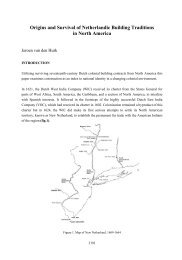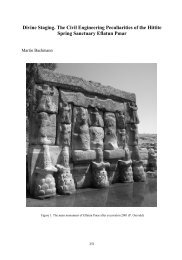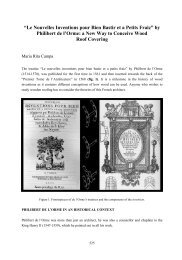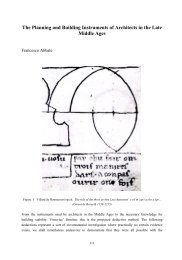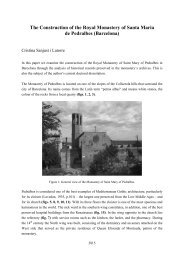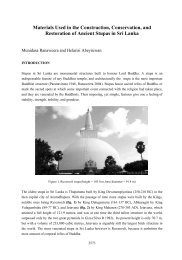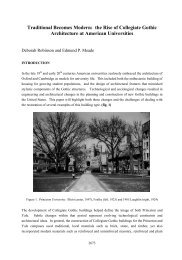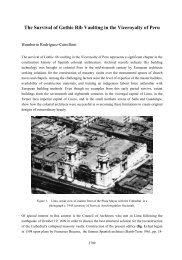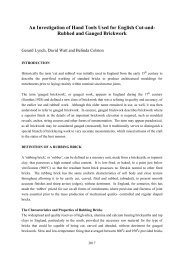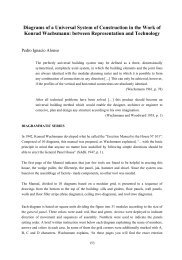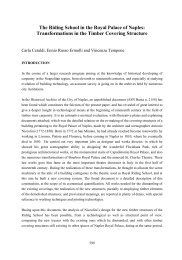bricks from the - Department of Architecture
bricks from the - Department of Architecture
bricks from the - Department of Architecture
Create successful ePaper yourself
Turn your PDF publications into a flip-book with our unique Google optimized e-Paper software.
6<br />
builder sand bri ckmak ers <strong>the</strong> word con tin u ed in u se, ',andin 1663 it<br />
was stated that '...,most sammel <strong>bricks</strong> are noe bett er than dust'.2<br />
The meaning <strong>of</strong> <strong>the</strong> term is clear <strong>from</strong> a demand <strong>of</strong> 1505 that <strong>bricks</strong><br />
for use at Little Saxham Hall should be 'wele and sufficiently brent<br />
and no semel nor broken breke be told ... 1.3 In <strong>the</strong> recent'literature<br />
<strong>the</strong> word has been taken to refer to <strong>the</strong> ,light pinkish colour that<br />
such <strong>bricks</strong> would typically show. Thus, L.S.Harley supposes that<br />
<strong>the</strong> word fis presumably a corruption <strong>of</strong> IIsalmonyll<strong>from</strong> <strong>the</strong> salmonpink<br />
or yellow-pink colour <strong>of</strong> <strong>the</strong> rough-textured body, due to lack<br />
<strong>of</strong> sintering <strong>of</strong> <strong>the</strong> clay particles. ,4 J .A.Wight is even more definite:<br />
'The contemporary term for less well-baked ~ <strong>bricks</strong> was 11 samelll,<br />
meaning salmon-coloured - or pinkish, instead <strong>of</strong> IIwell and sufficiently<br />
burned" red.' 5<br />
This derivation <strong>of</strong> <strong>the</strong> term is almost certainly incorrect, although<br />
apparently supported by C.T.Davis' reference in 1895 to<br />
'salmon stock' as opposed to'hard-burned <strong>bricks</strong>,.6 This is a variation<br />
<strong>of</strong> <strong>the</strong> East Anglian dialectal term 'sammen-<strong>bricks</strong>', explained,<br />
hesitantly, by Robert Forby in <strong>the</strong> early nineteenth century as<br />
'commonly understood to be salmon <strong>bricks</strong>, and to be so called, because<br />
... <strong>the</strong>y ... assurne a reddish hue, supposed to be something like <strong>the</strong><br />
flesh <strong>of</strong> <strong>the</strong> salmon. ,7 Forby is rightly suspicious, and O.E.D.<br />
correctly explains 'sammen' as an etymologizing alteration <strong>of</strong> <strong>the</strong><br />
older 'samel' .8 •<br />
It seems much more likely that <strong>the</strong> word 'sameI' is a compound<br />
<strong>of</strong> M.E. säm (<strong>from</strong> O.E. sam-, and ultimately <strong>from</strong> Gk ~~l- through<br />
Lat. semi- - meaning 'half,)9 and<strong>of</strong> M.E.elden (<strong>the</strong> verb-form <strong>of</strong><br />
<strong>the</strong> substantive eId, <strong>from</strong> O.E. aeled - meaning 'to light a fire',<br />
hence 'to burn'rrcf. Mod~E. 'to fire', as öf pottery, <strong>bricks</strong>, etc.).10<br />
Säm is not uncommonly used to form such compounds in M.E., for example<br />
in Langland's 'Chiboles and chiruylles and chiries säm-rede', or, in<br />
some MSS, '... säm-ripe' ,11and in ei<strong>the</strong>r case meaning 'half-ripe'.<br />
Similarly, <strong>the</strong> Hatton MS <strong>of</strong> St Luke's Gospel contains 'sam-cweoc'<br />
for 'half-alive' in <strong>the</strong> story <strong>of</strong> <strong>the</strong> Good Samaritan (Lk 10.30).12<br />
Such a compound as ~~säm-eld, giving 'sameI' with <strong>the</strong> meaning 'halfburned',<br />
'incompletely fired', is <strong>the</strong>refore entirely plausible}3 To<br />
be sure, nothing <strong>of</strong> any moment turns on this more'adequate understanding<br />
<strong>of</strong> <strong>the</strong> connotation <strong>of</strong> 'sameI', since its denotation is in<br />
any case entirely clear. Still, it is as weIl to ge~ <strong>the</strong> matter<br />
right: if one may be permitted to finish on a ,whimsical note, reference<br />
to 'salmon' is a red herring and a more convincing explanation<br />
is provided by <strong>the</strong> 'säm eId' story.<br />
Notes and References<br />
1. A number <strong>of</strong> references are ga<strong>the</strong>red toge<strong>the</strong>r in L.F.Salzman,<br />
Building in England down to 1540, 2nd ed., Oxford, 1967, p.144'<br />
(NB, not as index).<br />
2. B.Gerbier, Counsel and Advise ,ta All Builders, London, 1663,<br />
'p.53, quoted in L.S.Harley, 'A Typology <strong>of</strong> Brick: with Numerical<br />
Coding <strong>of</strong> Brick Characteristics', Journal <strong>of</strong> <strong>the</strong> British Archaeological<br />
Association, 3rd series, 38, 1974,- 79n.<br />
3. Salzman, op.cit., p.144.<br />
4. Harley, op.cit., 79.<br />
5. J.A.Wight, Brick Building in England <strong>from</strong> <strong>the</strong> Middle Ages to 1550,



